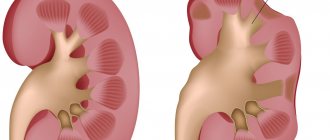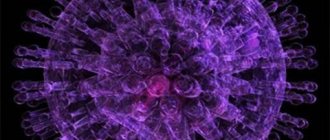It is blood that is the real “river of life” in the human body, and almost all processes occurring in the body depend on its normal composition.
The main problem that arises when the composition of this fluid environment of the body is disturbed is blood thickening, which leads to the work of many organs and systems in emergency mode. The most life-threatening consequences in such cases are heart attacks and strokes, which are a consequence of increased thrombus formation.
A little about the main functions of blood
The main function of red blood cells is to transport oxygen to the cells of the whole body.
All the tasks that the body sets for the blood are carried out thanks to the coordinated work of its following components:
- plasma – the liquid non-cellular part of blood;
- erythrocytes, platelets, represented by various elements leukocytes - cell mass (or suspended formed elements of blood);
- ions of various micro- and macroelements, enzymes, hormones and other substances entering the blood.
All of the above components perform the following functions:
- transport substances necessary for life (hormones, enzymes, nutrients and “fuel” elements) and remove “waste” materials accumulated in the blood (carbon dioxide, etc.);
- regulate the flow of water and electrolytes into the tissue;
- ensure the functioning of the immune system when pathogenic objects (microorganisms, own mutated cells) enter the blood.
A parameter such as blood thickness is determined by the balance between the liquid (plasma) and cellular (formed elements) part of the blood. It is this property that allows it to penetrate the smallest vessels and capillaries. This ensures the necessary delivery of blood to all tissues of the body.
Anemia (or anemia) is accompanied by a decrease in those blood parameters that relate to red blood cells. It is these red cells that carry oxygen, and if their production is disrupted, hypoxia of the tissues of all body systems develops.
What is “thick blood”
What is commonly called thick blood in simple terms is known to specialists as hyperviscosity syndrome or hypercoagulation syndrome. Such a condition in medicine is considered as a deviation from the norm, which can be contributed by various factors. But in order to fully understand what hypercoagulability syndrome is, you need to have an idea of the composition of the blood.
So, blood consists of the following components:
- cellular part (erythrocytes, platelets, leukocytes);
- non-cellular part (plasma, which is also a liquid component);
- ions of macro- and microelements, hormones, enzymes and other substances that are carried throughout the body by blood.
Content:
- What is “thick blood”
- Causes of “thick blood”
- What promotes thickening
- Who's at risk
- Why is condensation dangerous?
- How is the “thickness” of blood determined?
- External signs of thickening
- How to treat
- Blood thinners
Each of these components is vital for humans. But it is equally important that all components of the blood maintain a certain balance. And such a characteristic as blood viscosity is nothing more than the ratio between plasma and cell mass. If this balance is disturbed, the blood either becomes too thin or thickens. For example, when the body experiences a lack of erythrocytes (red blood cells), they speak of anemia (previously the term “anemia” was used), because the blood becomes unnaturally thin. The opposite effect occurs when there are too many red blood cells. But this is not the only reason for blood thickening.
Hyperthickness syndrome
Thickening (or hyperviscosity of the blood) worsens the rheological properties of this part of the body. This means that blood begins to move (flow) more slowly through the blood vessels. The following parameters can cause such violations:
- A joint increase in the density of both plasma and blood.
- An increase in hematocrit due to a violation of the ratio of formed elements to the volume of blood as a whole. Normally, the hematocrit is 4:6 (4 – formed part, 6 – plasma). For men, this figure is always slightly higher.
- Increased hemoglobin levels.
- Reduced elasticity and ability to deform red blood cells.
- Increasing the level of a protein responsible for blood clotting, fibrinogen.
- Increased sticking of red blood cells (or aggregation).
- Increased levels of paraproteins - pathological proteins released into the blood during diseases such as myeloma.
Blood density indicators are measured using a viscometer, which compares the speed of movement of this medium in relation to the same indicator of distilled water. Measurements are performed under the same conditions (i.e., same volume and temperature). Normally, blood flows 4-5 times slower than water, and blood viscosity is 1.050-1.064 g/ml.
Blood thickens due to the following factors:
- fermentopathy – conditions leading to incomplete breakdown of food, contamination of the blood with under-oxidized substances that provoke its acidification;
- disorders in the functioning of the liver, which are provoked by an insufficient supply of vitamins, minerals, decreased levels of enzymes and hormones, consumption of large amounts of salty, sweet, smoked, meat and canned foods;
- imbalance between blood cell mass and plasma in tumors of hematopoietic tissue (for example, leukemia);
- dehydration – loss of the liquid part of plasma due to excessive exercise, temperature exposure, taking diuretics, diarrhea, vomiting and poor absorption of water.
Interpretation
The absence of an increase in blood serum viscosity most likely excludes hyperviscosity syndrome, which in 85% of cases is a clinical manifestation of Waldenström's macroglobulinemia, less often of other paraproteinemias, dyslipidemia or inflammatory diseases. A negative test result does not exclude those forms of hyperviscosity syndrome that are caused by an increase in the number of cells in the bloodstream: polycythemia, leukemia, severe respiratory failure or sickle cell anemia. An increase in blood serum viscosity increases the clinical likelihood of hyperviscosity syndrome, which in 85% of cases is a clinical manifestation of Waldenström macroglobulinemia, and also occurs in multiple myeloma (especially IgA and IgG3 class), rheumatic, infectious diseases, dyslipidemia and cardiovascular diseases.
What are the signs that indicate that the blood is thick?
Headache and dizziness may be manifestations of blood thickening.
When the blood thickens, the following changes in well-being are felt:
- aching headaches;
- dizziness with loss of coordination of movement;
- muscle weakness;
- decreased tolerance to stress;
- noise in ears;
- fainting conditions;
- dry skin;
- paresthesia in the legs and arms: crawling, tingling, burning, numbness;
- blue discoloration (cyanosis) of the mucous membranes of the mouth, eyes and areas of the skin;
- increased sensitivity to low temperatures;
- drowsiness;
- frequent yawning;
- heaviness and pain in the legs;
- anxiety;
- depression;
- sleep disorders;
- absent-mindedness;
- slow bleeding after cuts;
- constipation and flatulence (sometimes).
When the blood is thick, women tend to have repeated miscarriages. In addition, blood tests often reveal elevated hemoglobin levels. Patients with blood hyperviscosity syndrome often exhibit one of the following syndromes:
- chronic fatigue,
- irritable bowel,
- candidiasis.
Treatment and prevention of thrombosis
Treatment of thrombosis includes anticoagulant and antiplatelet therapy, thrombolytic therapy, installation of an inferior vena cava cava filter, and surgical removal of the thrombus [5].
Complications of anticoagulant therapy must be kept in mind: major bleeding, heparin-induced thrombocytopenia and warfarin-induced skin necrosis [5]. To reduce the risk of continued thrombus formation, NSAIDs are used [2]. For the purpose of secondary prevention, small doses of heparin are prescribed. Non-drug treatment methods are also prescribed - elastic bandaging, compression hosiery, local hypothermia and exercise therapy [2, 4].
Prevention of thrombosis includes a number of measures used in situations of increased risk of thrombosis.
Primary prevention of atherothrombosis:
- systematic physical activity in the form of walking or morning exercises;
- blood pressure control, maintaining working blood pressure below 140/90 mmHg;
- control of blood sugar levels (less than 6 Mmol/l), early detection and treatment of diabetes mellitus;
- weight loss, body mass index less than 25 kg per m2;
- a diet limited in cholesterol and high-density fat (total cholesterol less than 5 mmol/l), fruits and vegetables;
- smoking cessation [3,7].
Primary prevention of venous thrombosis:
- compression underwear;
- bandaging with elastic bandages;
- drinking plenty of fluids, especially after surgery;
- regular exercise, walking, especially when traveling;
- prohibition of taking alcohol and sleeping pills in large doses;
- prohibition of the use of compressive shoes and clothing [2,5,6].
Sometimes, during periods of particular risk, anticoagulants are prescribed several days before the flight. There is no point in taking aspirin in such cases [5].
Why does blood thicken?
Hyperviscosity of the blood can be caused by hereditary or genetic reasons:
- there is a history of predisposition to the formation of blood clots;
- the history reveals cases of unjustified miscarriages.
Excessive blood thickening can be caused not only by hereditary causes, but also by external or internal factors:
- Aging. In all people, with age, the blood becomes thicker, and the vessels become more rigid and calcified.
- Smoking. Substances contained in tobacco smoke thicken the blood and increase the risk of blood clots.
- Overweight. Metabolic disorders in obesity lead to atherosclerotic changes in blood vessels and blood composition. As a result, it becomes more viscous.
- Alcohol abuse. Alcohol not only speeds up the removal of fluid from the body, but also thickens the blood.
- Dehydration. With a lack of water, the vessels begin to narrow, and this moment slows down the flow of blood, leading to its thickening.
- Prolonged bed rest. Conditions after long-term operations, illness or injury may lead to prolonged bed rest, which disrupts blood flow in organs and areas of the body. Stagnation in blood circulation leads to blood thickening.
- Pregnancy. The growth of the uterus as the fetus matures causes compression of the pelvic veins and leads to blood stagnation, which can result in the formation of blood clots.
- Use of contraceptives or hormone-based medications. This effect on the blood often leads to an increased risk of thrombosis and requires mandatory monitoring of the blood coagulation system while taking the drug.
- Men over 45. Such age-related changes lead to increased production of platelets, which can form blood clots.
- Physical inactivity (long sitting in a car, in an office, at another workplace, on an airplane, etc.). This problem is more relevant for megacities and older people, and the reasons for the formation of blood clots and blood thickening are the same as with long-term bed rest.
- Heavy metals, radiation, some toxic compounds. Mercury and other factors contained in predatory marine fish or old dentures can cause blood to thicken.
- Stressful situations. The release of stress hormones leads to vasoconstriction, slowing blood circulation and thickening the blood.
- Microorganisms: fungi, viruses, bacteria and parasites. Infectious and parasitic diseases are accompanied by a number of changes (fever, poisoning of the body with toxic waste products), which lead to blood thickening. The degree of such hyperviscosity of the blood depends on the nature and impact of the infectious or parasitic agent.
- High blood cholesterol levels. This factor can be provoked by insufficient intake of Omega 3 into the body or by incorrect preparation of your daily menu.
- Organ transplantation and implantation of various devices (valves, venous catheters, dialysis shunts, etc.), operations on blood vessels or their injuries. Impact on the walls of blood vessels or the heart leads to the formation of various irregularities. As a result, the risk of increased blood clots increases.
- Temperature effects: burns and hypothermia. Such factors lead to various consequences - dehydration, stress reactions to pain, disturbances in the functioning of the hematopoietic organs, which causes blood thickening.
- Inflammatory processes. Any chronic inflammation causes an increase in the level of leukocytes, proteins, fibrinogen and cholesterol. As a result, the blood becomes more viscous. A variety of diseases and conditions can lead to such changes: foodborne illnesses, liver cirrhosis, hepatitis, hypoxia, pancreatitis, heart failure, myocardial infarction, diabetes mellitus, atrial fibrillation, adrenal dysfunction, leukemia, ischemic stroke and many others.
- Taking diuretics, non-steroidal anti-inflammatory drugs and drugs based on estrogen and phytoestrogen leads to blood thickening due to various effects of medications on the composition of the blood and hematopoietic organs.
Blood thinners
The most common foods that reduce blood viscosity include ginger, cranberry, garlic and lemon. Seafood, vegetables and fruits, fish, and herbs have a slightly weaker effect.
- Ginger. The root of this plant has healing properties. It is used as a food seasoning mainly in powdered or raw form. It has a rich chemical composition, in which the most important place in terms of blood thinning belongs to natural antioxidants and lipids. For reception, you can prepare tea from half a teaspoon of grated ginger, which is infused in one liter of boiling water. This is the daily dose. You should not exceed it due to the high activity of ginger, which is contraindicated when taking most cardiac and blood-thinning medications, severe damage to the liver and kidneys, the presence of sources of bleeding, increased temperature, and also in hot weather.
- Cranberry. A wonderful berry with wonderful properties, one of which is reducing blood viscosity. The berries of this plant are mainly used, both fresh and dried. You can take whole fruits, or you can include them in juices, fruit drinks, and infusions. It is acceptable to prepare teas and compotes containing only cranberries or their combination with other ingredients. The only contraindication for use is gastritis and gastric ulcer with high acidity due to the high content of acids in its composition.
- Garlic. Refers to products with strong blood-thinning properties. It is used raw and as a seasoning for food products. Eating one clove of garlic per day has a very good anti-clotting effect. Contraindications for use may include gastritis, hemorrhoids, heart disease, pregnancy and breastfeeding.
- Lemon. One of the few products that has no contraindications for use. Lemon fruits have beneficial properties. At the same time, both its pulp and peel are active. Only the seeds have toxic properties. You can take lemon in any form with the addition of honey, tea or plain water.
- Cayenne pepper. Red hot pepper can greatly thin the blood due to its high level of salicylates. It can be crushed and added as a seasoning to food. Cayenne pepper can also lower blood pressure and improve circulation.
Which doctor should I contact?
Some medications can cause blood to thicken.
If you experience frequent dizziness, aching headaches, dry skin and other signs of blood thickening, you need to contact a therapist, who will prescribe the necessary tests that reflect the state of its composition - a coagulogram and a general detailed blood test. To find out the reasons for such deviations, consultations with other specialists may be necessary: an endocrinologist, hepatologist, etc. After identifying the causes of blood thickening, appropriate treatment for the underlying disease is prescribed or the cause of changes in its parameters is eliminated.
Blood is the main source of nutrients for our body. It introduces them into tissues and removes from there harmful components that accumulate after the completion of physiological processes. A variety of external and internal factors can change its composition and influence the rheological properties, the effects of which should be stopped.
To determine blood density indicators, you should regularly take a general blood test. The frequency of such monitoring studies performed for preventive purposes is determined by age and the presence of concomitant diseases.
What should the normal indicator be?
The normal level of D-dimer in blood plasma is 250 ng/ml. this indicator confirms that the patient is not at risk of thrombosis. In pregnant women, this figure can reach 1000 ng/ml or more, i.e. grow 3–4 times.
Normal D-dimer levels in pregnant women:
- up to 450–500 ng/ml in the 1st trimester;
- up to 900–920 ng/ml in the 2nd trimester;
- up to 1450–1500 ng/ml in the 3rd trimester.
If a pregnant woman, on the contrary, has a low level, she is urgently referred to a hematologist, who will prescribe medications. A decrease in dedimer during pregnancy is a sign of long-standing problems with blood clotting that arose long before pregnancy. With good treatment, childbirth proceeds normally.









